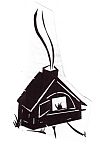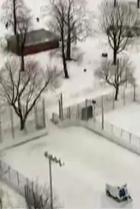
Centre For Local Research into Public Space (CELOS)
May 25, 2025: Food in Parks
In December 1955, a request went to Toronto city council to allow food concessions at Dufferin and Earlscourt rinks. But permission was declined, without explanation. And it stayed that way for forty years.
In 1993, I had a conversation with the director of recreation of the time, Mario Zanetti. He had supported our idea of making a big sandpit at the Dufferin Grove playground, where kids could build. The kids loved it. I told him we wanted to do more, including making campfires with the kids who came to play, and improving the rink for winter. But there were so many rules against almost everything! The general atmosphere seemed to be "no you can't."
Mario said that the best way for people to make changes in a bureaucracy was if they used two basic rules: (1) start small and (2) use the rules against themselves.

campfire
So in 1994 we asked if we could have one campfire in the sandpit, to celebrate a Mexican festival. Campfires were not normally permitted but ethnic festivals were encouraged. So permission was granted. When that worked well, we asked if we could bring in our Guatemalan friend Isabel Peres to show how tortillas are made over a campfire. The preparation of food was not allowed. But at that time many Toronto schools had heritage programs, and we said that we wanted to build on the schools' lead. So we got permission. There was no talk of eating the food, just demonstrating how it was traditionally made.
The demonstration was popular, so Isabel came again, to demonstrate making simple tortilla and bean snacks called tostadas. School classes came, and in summer Isabel branched out into making campfire donuts the way she used to make them back home. You can see the result in this little film, made by Amnon Buchbinder.
As the film shows, it's not possible to demonstrate making food and then throwing it away. So that's how food came to Dufferin Grove Park -- by the back door.

bake oven
Then in 1995, we got permission to build the first outdoor bake oven, much like the village ovens that were still standing in many Portuguese villages. At that time Portuguese immigrants from the Acores and the mainland were still the largest ethnic group in this neighbourhood. That oven of course brought pizza, and more school classes, and community gatherings of many sorts. Some of the stories of what happened next are here.
How did it work?
The oven didn't run itself, of course. Neither did the 7-days-a-week rink snack bar in the wintertime, or the 7-days-a-week playground cafe in summer, or the weekly Friday Night Supper, or the community pizza day twice a week, or the many small food-related gatherings that can grow at a welcoming park. At Dufferin Grove Park, food gradually became a way of connecting all recreation programs and connecting neighbours to one another. This ecology was built layer by layer by front-line city rec staff working in close partnership with both CELOS and a diverse group of park friends. The staff pulled it all together.
In 2010, the director of recreation of that time asked the staff to describe their daily tasks. Their list is here. The food in the park ARCHIVE is here.
None of this could have happened if it hadn't been allowed to grow by Parks and Rec management. But in 2010, management support started to dry up. A highly centralized citywide reorganization was put in place at Parks and Rec, coupled with a new Canadian Union of Public Employees [CUPE] collective agreement that shut the door to most employee-generated innovation. The food programs began to shrink. Then in 2020 with the two years of lockdowns and the follow-up restrictions on public space, all the city-run food programs disappeared.
Very little has come back. One day, maybe new park friends and new city staff will begin the next partnership:
(start small and use the rules against themselves......)



 Show search options
Show search options




 You are on the [Blog 25 May 2025 Food In Parks] page of folder [Research Library ]
You are on the [Blog 25 May 2025 Food In Parks] page of folder [Research Library ] For the cover page of this folder go to the
For the cover page of this folder go to the